|
|
|
|
|
|
TJ Magna Custom Polyurethane Engine Mount
This page describes the creation of a custom polyurethane engine mount for a Mitsubishi TJ Magna,
as a replacement for rubber engine mounts with a short lifespan.
Background
After replacing the rear rubber engine mount on my
U12 Pintara too many times,
I decided to go down the homebrew path, and had an engine mount cast in polyurethane.
The polyurethane mount was a success, significantly reducing engine movement, while
not introducing too much engine vibration into the cabin.
After breaking the top right rubber engine mount on my TJ Magna wagon,
I decided to get it cast in polyurethane too.
Breaking Mounts
A broken engine mount results in excessive engine movement,
which often translates into wheel hop, particularly in front-wheel drive cars.
A quote from my local Mitsubishi dealer indicated a replacement top right engine mount
would be approx $240.
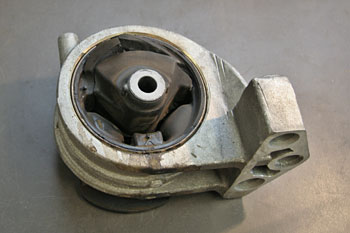
yet another broken engine mount
Apparently it's a common problem, and I have heard from numerous other people
that they have had similar issues with their Magnas breaking engine mounts.
Alternatives
After-market engine mounts made of polyurethane are available for some cars,
and someone on the AussieMagna forums
sells polyurethane inserts for approx $110.
However, after a positive (and cheaper) experience with polyurethane mounts
on my U12 Pintara, I decided to get this mount
re-cast in polyurethane.
Custom Mounts
You'll need to find a workshop that does custom polyurethane casting,
and they should be able to cast a new mount relatively cheaply.
My custom mount was cast by Peter at
Advanced Polymer Technology,
for AU$60, and I got the mount back within a week.
Advanced Polymer Technology is located in Armadale, approximately 25km south of Perth,
in Western Australia, a convenient 10 minute drive from my house.
Advanced Polymer Technology provide polyurethane linings and products for various industries,
and also can do custom polyurethane parts, including engine mounts.
Note that you'll need a spare engine mount, as it'll typically take a week or so to get
the polyurethane cast and cured.
Alternatively, you'll need to have your car off the road for a week or so, while
the mount is curing.
Another option is to source another mount from your local wreckers, and get it
cast in polyurethane.
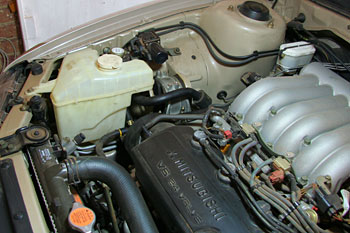
engine bay
The first step is to remove the mount from the car.
This is relatively easy, and requires the following:
- support weight of engine with a jack under the sump
- remove the washer bottle
- undo the bolt through the centre of the mount
- undo the two nuts and one bolt attaching the mount to the block
- remove the mount
The nuts and bolt attaching the mount to the engine block are not easily accessible.
I had to buy a deep 17mm socket, else there was no way I could loosen these nuts and bolt.
The next step is to strip all the rubber out of the mount,
just leaving the outer ring, and the centre pin.
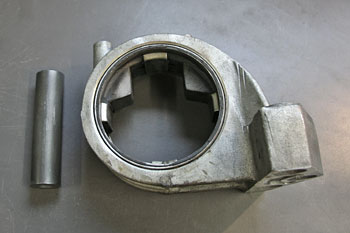
mount with rubber removed
I used a sharp wood chisel to remove the bulk of the rubber, and then used
a rotary wire brush in a drill to clean up the centre pin, and some carving drill bits
to remove the remaining rubber from the outer ring.
Note that the sleeve inside the mount can probably be removed (resulting in a circular hole), but
I chose to leave it intact, as the raised sections provide plenty of surface area for the
polyurethane to bond and key to.
Based on my previous experiences, I chose
to use 65 Shore A hardness polyurethane.
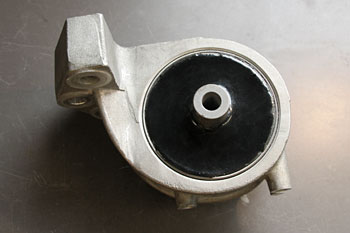
newly cast polyurethane mount
To provide some additional flexibility and movement in the new mount,
some 10mm holes were drilled around the centre pin.
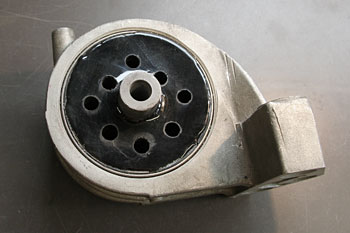
polyurethane mount with drilled holes
Installing the Mount
Installation of the mount is the reversal of removing it.
However, due to the reduced movement in the mount itself, you may need to
push the engine somewhat to get the various bolts to line up.
Conclusion
The new mount certainly reduces engine movement, yet doesn't result in too much engine
vibrations being transmitted to the chassis.
Prior to replacing the engine mount, my Magna was very susceptible to wheel hop,
particularly with the front left wheel, when taking a left corner.
The polyurethane mount has almost totally eliminated the wheel hop.
I was expecting the new mount to reduce the wheel hop, but it has exceeded my expectations.
The polyurethane mount (at AU$60) is a lot cheaper than a replacement rubber mount from
Mitsubishi (at AU$240), and should last much longer.
Even taking into account the fact that I had to buy a deep 17mm socket (approx AU$13),
the polyurethane mount still works out to be much cheaper.
However, as I was unable to source a cheap (broken) replacement mount, my Magna was off the road for a week
while the mount was cast and while it cured.
References
Other Custom Polyurethane Engine Mounts
last updated 2 Nov 2018
|
|
|
|
|
|
|
|
|

